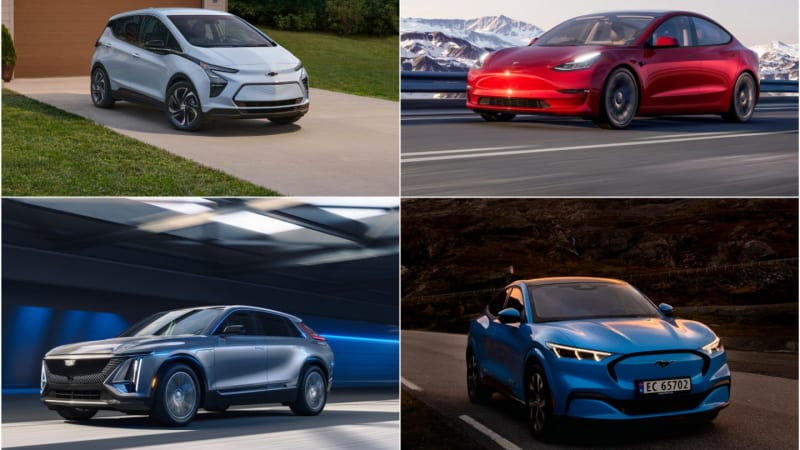How the new point-of-sale EV tax credits will work in 2024

Figuring out EV tax credits for plug-in vehicles like the
Chevrolet Bolt,
Tesla Model 3,
Cadillac Lyriq, and
Ford Mustang Mach-E is complex.
Tesla; Chevrolet; Cadillac; Ford
The rules for how electric car buyers receive federal tax credits have changed.
The new guidelines benefit buyers who are taking the plunge to plug-in.
But there are caveats that EV shoppers should be aware of, experts say.
It might be better to wait a few months to buy that EV you’ve been eyeing — but that advice comes with a caveat.
Let’s start with the good news: Starting January 2024, new and used federal electric vehicle credits can be applied as a point of sale discount on a car’s purchase price or as a rebate.
How does that differ from what’s been available this year?
Throughout 2023, car shoppers have been able to take advantage of revised EV tax credits incentivizing them to buy plug-in.
But buyers — either of a new or used electric car — would have to wait to receive their refund, as it was used as a proper tax credit at the end of the year against one’s tax liability.
So, if you bought a new EV that qualified for a credit of either $3,750 or the full $7,500, you’d have to wait until the following tax season to get that taken off what you owe. If you bought a used plug-in vehicle that qualified for a credit of up to $4,000, you’d also have to wait. You could also only claim what you owed on your taxes.
That could be a barrier for many car shoppers, and especially on the used side.
For instance, some shoppers going used might not have a $4,000 tax liability at the end of the year. But instead of receiving a rebate, they’d lose whatever amount of the used EV tax credit they were owed, if they owed fewer taxes than that.
So how do the new rules work?
Starting next year, buyers can go into a dealership and transfer their EV credit to the dealer. The dealer will sell the vehicle and either apply the discount to the price of the car or give cash back.
This new system ensures that eligible buyers receive the full credit that the vehicle is entitled to, regardless of their end-of-year tax liability.
It also places the onus of juggling the tax credits to dealers. Dealers must be registered with the IRS to be able to participate, and the IRS is incentivizing them to participate by saying they will get paid back within 72 hours.
Given the changes, it might make sense for buyers to wait to get their electric car until next year, resources like Plug In America and other experts recommend.
“One of the questions there is: Do they know what their tax liability is going to look like for 2023? If not, it may be beneficial to wait until 2024 and use this as a point of sale credit,” Liz Najman, Recurrent lead researcher, told Insider. “I know for a lot of people waiting a year to get the credit doesn’t do as much as it does to get a purchase price discount.
“It’s been shown time and time again that particularly for low and middle-income households, upfront rebates and purchase prices are a much bigger driver than tax credits at the end of the year,” she added. “It may make the difference for affordability.”
What’s the caveat?
The industry is waiting on updated guidelines as to which new electrified vehicles will qualify for partial or full tax credits come 2024.
The rules are complex and all sorts of factors are used to define a new EV’s credit eligibility, like whether the car was manufactured in the US, the sourcing of critical minerals and battery content from the US or partner countries, and the extent to which the car has materials from “foreign entities of concern,” requirements for which kick in next year.
As a result, it’s unclear which new plug-in vehicles — that currently qualify for credits and are currently on the list — might be off the list next year. The Tesla Model 3, for instance, might only qualify for half of the credit in 2024. There also might be vehicles that don’t currently qualify that join the list next year if they abide by next year’s guidelines.
“It’s possible that some of the vehicles that are eligible for the full $7,500 credit this year could see a reduction in that credit,” Akshay Honnatti, EY Americas sustainability tax services leader, said. “There is going to be a period when some vehicles are just not going to be able to take the full benefit.”
Shoppers should keep an eye on end-of-2023 EV deals that dealers might run in advance of them essentially having to take over the tax credit responsibility. But shoppers should also beware that dealers could drive used EV prices up next year, given that the discount rules might incentivize shoppers to buy.
Are you a dealer or car salesperson selling EVs? Do you have an opinion to share? Reach out to this reporter at astjohn@insider.com.



